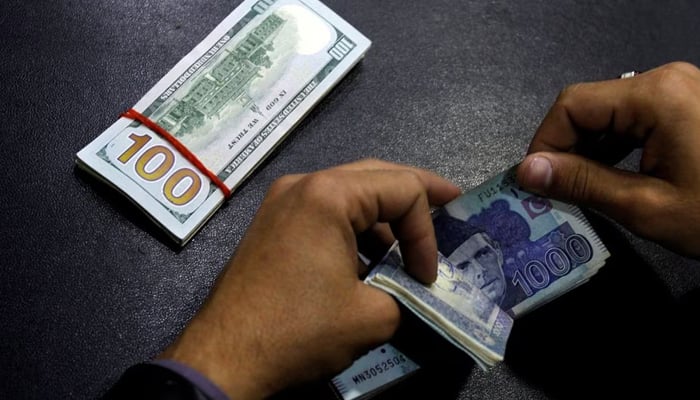- IMF set limit of 1.25% between interbank, open market rates.
- Interim PM selects economic experts to deal with economic woes.
- Open market has witnessed nosedive in rupee value against dollar.
ISLAMABAD: With continuous fall in the exchange rate, Pakistani authorities have been left with no other option but to request the International Monetary Fund (IMF) to review the Fund’s condition of keeping the difference between interbank and open market dollar rates not more than 1.25%, it emerged on Tuesday.
Amid massive fluctuations in the currency market in recent days, the Ministry of Finance and the State Bank of Pakistan (SBP) were silent over the depreciation of the rupee against the dollar.
However, many official sources claimed that the newly-appointed Minister for Finance Dr Shamshad Akhtar is currently busy getting briefings from different ministries before finalising a prescription to fix the economic ills.
The caretaker prime minister has selected two economic experts, Dr Shamshad Akhtar and Adviser on Finance Dr Waqar Masood, to deal with the economic challenges.
The IMF’s Standby Arrangement (SBA) programme of $3 billion placed a continuous structural benchmark under which the average premium between the interbank and open market rate will be no more than 1.25% during any consecutive five business-day period.
“This flawed structural benchmark has changed dynamics of the currency market as the open market rates will start driving the exchange rate against the earlier practice that interbank used to be the driving force behind the exchange rate fluctuations,” top official sources confirmed while talking to The News.
Now the open market has witnessed a nosedive in rupee value against the dollar and the rate hovered around Rs310 to Rs315 depending upon those who possessed valid traveling documents, including passport, visa and air tickets and those who are just buying dollars owing to speculations.
On the other hand, the interbank market also witnessed an all-time low of Rs299 against the US dollar in the interbank market.
“This practice might continue if the IMF condition for keeping the rate between interbank and open markets not more than 1.25% intact because it has changed the dynamics of Pakistan’s currency market. Now the caretaker government will have to make a request to the IMF for review of this policy structural benchmark,” said a top official.
The SBP has been continuously breaching this condition for the last several days and there is no limit to keep the exchange rate stable keeping in view the volatile environment when Pakistan is desperate to attract dollar inflows at a time when the outflows exceed the inflows with substantial margins.
Pakistan has obtained $2.8 billion in the shape of time deposits and guaranteed loans from China as well as from other multilateral and bilateral creditors. There is another $2.2 billion received by the SBP from the IMF and other bilateral creditors to shore up the foreign exchange reserves but this kind of dollar inflows failed to stabilise the exchange rate.
The currency market remained unstable owing to various factors, including the removal of restrictions on imports after which the current account deficit surged to $1 billion in July 2023. Remittances and exports also dropped against the envisaged targets. All these circumstances put pressure on the exchange rate when the macroeconomic fundamentals are not up to the desired mark.
When contacted, former adviser Ministry of Finance Dr Khaqan Najeeb on Tuesday said that in the short term, the rupee is adjusting due to higher import numbers, clearance of backlog for containers. Falling inflows of remittance and exports and the interbank market doing a catchup with the kerb market in the hope of fulfilling an IMF structural benchmark.
An uncomfortable SBA that may need reconsideration is specifying that 1.25% difference will not be breached between kerb and interbank for five days in a row. Data does point to the breach of the continuous structural benchmark and is appearing hard to maintain, he maintained.
He felt importers are relying on the kerb market as liquidity remains constrained in the interbank. This along with dollar buying as a safe store of value keeps the kerb market rising and the interbank following the rising trend to close the gap between the two rates. He concluded by saying that creating certainty, and a response giving clarity on future economic plans and strategies for meeting the IMF targets by authorities, is necessary.

 Latest News2 days ago
Latest News2 days ago
 Business2 days ago
Business2 days ago
 Latest News1 day ago
Latest News1 day ago
 Latest News1 day ago
Latest News1 day ago
 Entertainment2 days ago
Entertainment2 days ago
 Latest News2 days ago
Latest News2 days ago
 Latest News1 day ago
Latest News1 day ago
 Latest News1 day ago
Latest News1 day ago






















